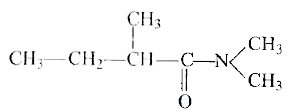ANaNO2/HCI−−−−−−−−→0∘CBH2O−−→373KCCH2N2−−−→HBF4 Anisole [A] is :
Benzene
Anisole
aniline
phenetole
The correct Answer is:C
To solve the question, we need to identify the reactant A that leads to the final product, anisole, through the given reaction sequence. Let's break down the steps:
Step 1: Identify the final product
The final product given is anisole, which has the structure of a benzene ring with a methoxy group (-OCH₃) attached to it.
Step 2: Analyze the reagents and conditions
The first reagent mentioned is NaNO₂ in the presence of HCl at 0°C. This combination is typically used for the diazotization of primary amines.
Step 3: Determine the structure of reactant A
Since the first step involves diazotization, reactant A must be a primary amine that contains a benzene ring. The simplest primary amine that fits this description is aniline (C₆H₅NH₂), which has a benzene ring and an amino group (-NH₂).
Step 4: Reaction of A to form B
When aniline (A) reacts with NaNO₂ and HCl, it undergoes diazotization to form benzene diazonium chloride (B).
Step 5: Conversion of B to C
The next step involves heating benzene diazonium chloride (B) with water at 373 K. This reaction leads to the formation of phenol (C).
Step 6: Methylation of C to form the final product
Finally, phenol (C) reacts with CH₂N₂ in the presence of HBF₄, which is a methylating agent. This reaction replaces one of the hydrogen atoms on the phenol with a methyl group, resulting in the formation of anisole.
Conclusion
Thus, the reactant A is aniline (C₆H₅NH₂).
Answer
A is Aniline (C₆H₅NH₂).
---
The final product given is anisole, which has the structure of a benzene ring with a methoxy group (-OCH₃) attached to it.
The first reagent mentioned is NaNO₂ in the presence of HCl at 0°C. This combination is typically used for the diazotization of primary amines.
Since the first step involves diazotization, reactant A must be a primary amine that contains a benzene ring. The simplest primary amine that fits this description is aniline (C₆H₅NH₂), which has a benzene ring and an amino group (-NH₂).
When aniline (A) reacts with NaNO₂ and HCl, it undergoes diazotization to form benzene diazonium chloride (B).
The next step involves heating benzene diazonium chloride (B) with water at 373 K. This reaction leads to the formation of phenol (C).
Finally, phenol (C) reacts with CH₂N₂ in the presence of HBF₄, which is a methylating agent. This reaction replaces one of the hydrogen atoms on the phenol with a methyl group, resulting in the formation of anisole.
Thus, the reactant A is aniline (C₆H₅NH₂).
A is Aniline (C₆H₅NH₂).
Topper's Solved these Questions
- AMINESBOOK - VMC MODULES ENGLISHCHAPTER - AMINESEXERCISE - ENABLE
45 Videos
- AMINESBOOK - VMC MODULES ENGLISHCHAPTER - AMINESEXERCISE - EFFICIENT
49 Videos
- ALDEHYDES,KETONES & CARBOXYLIC ACIDS BOOK - VMC MODULES ENGLISHCHAPTER - ALDEHYDES,KETONES & CARBOXYLIC ACIDS EXERCISE - IN-CHAPTER EXERCISE-M
10 Videos
- ATOMIC STRUCTUREBOOK - VMC MODULES ENGLISHCHAPTER - ATOMIC STRUCTUREEXERCISE - JEE Advanced (Archive )
67 Videos
Similar Questions
Knowledge Check
CH3−CH3∣C∣CH3H+H2C=CH2HF−−−→2.5∘C (A) , (A) is :
A B
B C
C DCH3−CH∣CH3−CH2−CH=CH2
DCH3−CH∣CH3−CH2−CH=CH2H3C−CH2−CH3∣CH−C∣∣O−NH2Br2+KOH−−−−−−−−−→ΔA1.CH3I(excess)−−−−−−−−−−−−→2.AgOH,ΔB
The major product (B) is :ACH3−CH2−CH=CH2B CH3C−CH=CH−CH3D
CH3C−CH=CH−CH3D
The IUPAC name of CH3−O∣∣C−C∣C2H5H−C∣CH3H−CH3 is
A3-(Methylethyl) pentan-2-oneB3-(Methylethyl)pentan-4-oneC3-Ethyl-4-methylpentan-2-oneD3-Ethyl-2-methylpentan-4-one
ASn/HCI−−−−−→BNaNO2−−−−−→HCI,0∘CCHOH−−→DZn dust −−−−−→ΔC6H6, Functional groups in A, B ,C and D respective are :
View SolutionCH3−CH3∣CH∣CH3KmnO4−−−−→(A)H+−−→Δ(B)HBr−−−→ROOR(C)
Product (C) in the above reactions is :
View SolutionIdentify Y in the reaction,
C6H5NH2NaNO2/HCl−−−−−−−→273KXH2O−−−−−−−→dil. H2SO4Y
View SolutionIdentify the compounds A, B and C:
H−C≡C−HH2O−−−−−−−−−−−→dil.H2SO4+HgSO4AH2−−→[Ni]B140∘C−−−−−−−→cons H2SO4C
View SolutionWhich of the following has an asymmetric carbon atom ?
(a)CH3−CH2−CH2Br
(b)CH3−H∣C∣Br−C∣CH3H−CH3
(c)CH3−cH2−Br∣C∣CH3−CH3
(d)CH3−∣CH3∣C∣Br−CH2−CH2−CH3
View Solution
